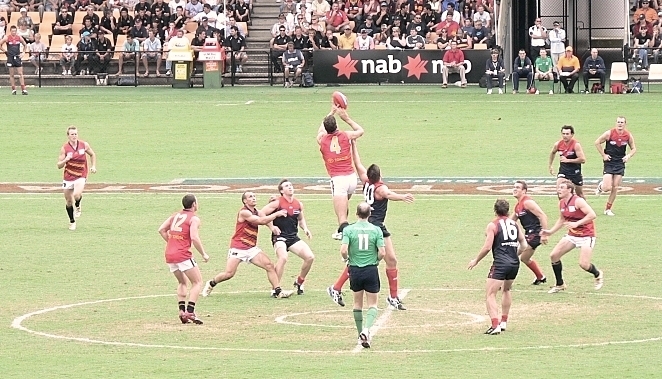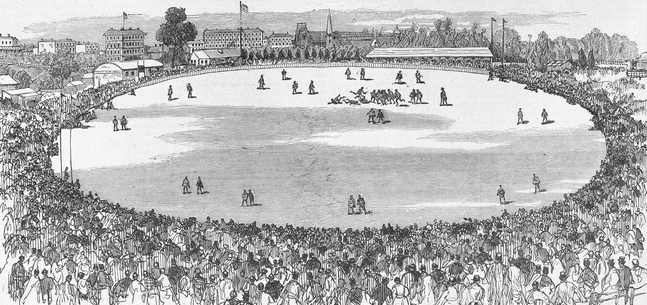|
Australian Amateur Football Council
The Australian Amateur Football Council (AAFC) is the governing body of amateur Australian football in the states of Victoria, South Australia, and Tasmania in Australia. The council was formed in 1933. Overview The council organises amateur interstate and international representative matches, and is responsible for several amateur leagues, including the Victorian Amateur Football Association, South Australian Amateur Football League and Western Australian Amateur Football League. Not all Australian amateur leagues are represented: the Northern Tasmanian Football Association has been a member in the past and a U23 All-Australian team played an open Tasmanian team in 2007. The Top End Australian Football Association, AFLQ State Association and Sydney AFL are not members of the AAFC, as these leagues do not follow as strict criteria of "amateur". The AAFC was represented by a voting delegate on the Australian National Football Council from 1949 until the ANFC's dissolution in ... [...More Info...] [...Related Items...] OR: [Wikipedia] [Google] [Baidu] |
Australian Football
Australian football, also called Australian rules football or Aussie rules, or more simply football or footy, is a contact sport played between two teams of 18 players on an Australian rules football playing field, oval field, often a modified cricket ground. Points are scored by kicking the Football (ball)#Australian rules football, oval ball between the central goal posts (worth six points), or between a central and outer post (worth one point, otherwise known as a "behind"). During general play, players may position themselves anywhere on the field and use any part of their bodies to move the ball. The primary methods are kick (football), kicking, handball (Australian rules football), handballing and running with the ball. There are rules on how the ball can be handled; for example, players running with the ball must intermittently running bounce, bounce or touch it on the ground. Throwing the ball is not allowed, and players must not get caught holding the ball. A distinct ... [...More Info...] [...Related Items...] OR: [Wikipedia] [Google] [Baidu] |
Australian National Football Council
The Australian National Football Council (ANFC) was the national governing body for Australian rules football in Australia from 1906 until 1995. The council was a body of delegates representing each of the principal leagues which controlled the sport in their respective regions. The council was the owner of the laws of the game and managed interstate administrative and football matters. Its function was superseded by the AFL Commission. The council underwent several name changes during its existence, and at different times it was also known as: the Australasian Football Council (1906–1919), the Australian Football Council (1920–1927 and 1973–1975), the National Football League (NFL) (1975–1989) and the National Australian Football Council (NAFC) (1989–1995). Structure and purpose Throughout its history, the ANFC was the top level administrative body for the sport of Australian rules football. In this capacity, it served four main functions: *It was the owner of the of ... [...More Info...] [...Related Items...] OR: [Wikipedia] [Google] [Baidu] |
Gaelic Athletic Association
The Gaelic Athletic Association (GAA; ga, Cumann Lúthchleas Gael ; CLG) is an Irish international amateur sporting and cultural organisation, focused primarily on promoting indigenous Gaelic games and pastimes, which include the traditional Irish sports of hurling, camogie, Gaelic football, Gaelic handball and rounders. The association also promotes Irish music and dance, as well as the Irish language. As of 2014, the organisation had over 500,000 members worldwide, and declared total revenues of €65.6 million in 2017. The Games Administration Committee (GAC) of the Gaelic Athletic Association (GAA) governing bodies organise the fixture list of Gaelic games within a GAA county or provincial councils. Gaelic football and hurling are the most popular activities promoted by the organisation, and the most popular sports in the Republic of Ireland in terms of attendances. Gaelic football is also the second most popular participation sport in Northern Ireland. The women' ... [...More Info...] [...Related Items...] OR: [Wikipedia] [Google] [Baidu] |
International Rules Football
International rules football ( ga, Peil na rialacha idirnáisiunta; also known as international rules in Australia and compromise rules or Aussie rules in Ireland) is a team sport consisting of a hybrid of football codes, which was developed to facilitate international representative matches between Australian rules football players and Gaelic football players. The first tour, known as the Australian Football World Tour, took place in 1967, with matches played in Ireland, the United Kingdom, and the United States. The following year, games were played between Australia and a touring County Meath Gaelic football team, Meath being the reigning All-Ireland senior football champions. Following intermittent international tests between Australia and Ireland, the International Rules Series between the senior Australia international rules football team and Ireland international rules football team has been played intermittently since 1984, and has generally been a closely match ... [...More Info...] [...Related Items...] OR: [Wikipedia] [Google] [Baidu] |
25-metre Penalty
In the sport of Australian rules football, the 50-metre penalty is applied by umpires to a number of different infractions when a free kick or mark has already been paid. The laws of the game also allow leagues to use a 25-metre penalty in place of a 50-metre penalty. Examples of leagues which do this include the South Australian National Football League (SANFL), Victorian Amateur Football Association (VAFA), Australian Football International Cup and the Australian Amateur Football Council. Rules When the umpire pays a 50-metre penalty, he calls time-off, measures out approximately fifty metres from the spot of the mark by running in a straight line towards the goals, and setting the new mark; if the player is already within 50 metres of goal, the mark becomes the exact centre of the goal line. Players are given a short period of time to follow the play down the field before the clock is restarted. The player can play on at any time while the umpire is measuring out the 50-metre ... [...More Info...] [...Related Items...] OR: [Wikipedia] [Google] [Baidu] |
Ejection (sports)
In sports, an ejection (also known as dismissal, sending-off, disqualification, or early shower) is the removal of a participant from a contest due to a violation of the sport's rules. The exact violations that lead to an ejection vary depending upon the sport, but common causes for ejection include unsportsmanlike conduct, violent acts against another participant that are beyond the sport's generally accepted standards for such acts, abuse against officials, violations of the sport's rules that the contest official deems to be egregious, or the use of an illegal substance to better a player's game. Most sports have provisions that allow players to be ejected, and many allow for the ejection of coaches, managers, or other non-playing personnel. In sports that use penalty cards, a red card is often used to signal dismissals. The decision to eject a participant usually lies with one or more officials present at the contest (e.g., referees or umpires). In addition to removal from t ... [...More Info...] [...Related Items...] OR: [Wikipedia] [Google] [Baidu] |
Laws Of Australian Football
The laws of Australian rules football were first created by the Melbourne Football Club in 1859 and have been refined over the years as the sport evolved into its modern form. The laws significantly predate the advent of a governing body for the sport. The first national and international body, the Australasian Football Council (AFC), was formed in 1905 and became responsible for the laws, although individual leagues retained a wide discretion to vary them. Since 1994, after the establishment of a nation-wide Australian Football League (AFL), the rules for the game have been maintained by the AFL Commission through its AFL Competition Committee. Australian rules football is a contact sport played between two teams of eighteen players on an oval-shaped field, often a modified cricket ground. Points are scored by kicking the oval-shaped ball between goal posts (worth six points) or between behind posts (worth one point). During general play, players may position themselves an ... [...More Info...] [...Related Items...] OR: [Wikipedia] [Google] [Baidu] |
Interstate Matches In Australian Rules Football
Representative matches in Australian rules football are matches between representative teams played under the Australian rules, most notably of the colonies and later Australian states and territories that have been held since 1879. For most of the 20th century, the absence of a national club competition in Australia and international matches meant that intercolonial and later interstate matches were regarded with great importance. Interstate matches were, in most cases, sanctioned and coordinated by the Australian National Football Council (ANFC), which organised every national championship series from the first-ever national carnival, the Jubilee Australasian Football Carnival in 1908 with the exception of the last-ever series: the 1993 State of Origin Championships, which was run by the AFL Commission. The series took place on approximately three-yearly intervals between 1908 and 1993; these were usually a fortnight-long tournament staged in a single host city, although so ... [...More Info...] [...Related Items...] OR: [Wikipedia] [Google] [Baidu] |
South Australian National Football League
The South Australian National Football League, or SANFL ( or ''S-A-N-F-L''), is an Australian rules football league based in the Australian state of South Australia. It is also the state's governing body for the sport. Originally formed as the South Australian Football Association on 30 April 1877, the SANFL is the oldest surviving football league of any code in Australia and is the 7th oldest club football league in the world. Consisting of a single division competition, since the admission of the Adelaide Crows AFL Reserves in 2014 the season, has been a 10-team, 18-round home-and-away (regular) season from April to September. The top five teams play-off in a final series culminating in the grand final for the Thomas Seymour Hill Premiership Trophy. The grand final had traditionally been held at Football Park in October, generally the week after the AFL Grand Final, though this was altered ahead of the 2014 season resulting in Adelaide Oval hosting the grand final in the pe ... [...More Info...] [...Related Items...] OR: [Wikipedia] [Google] [Baidu] |
Australian Football League
The Australian Football League (AFL) is the only fully professional competition of Australian rules football. Through the AFL Commission, the AFL also serves as the sport's governing body and is responsible for controlling the laws of the game. Originally known as the Victorian Football League (VFL), it was founded in 1896 as a breakaway competition from the Victorian Football Association (VFA), with its inaugural season commencing the following year. The VFL, aiming to become a national competition, began expanding beyond Victoria to other Australian states in the 1980s, and changed its name to the AFL in 1990. The league currently consists of 18 teams spread over five of Australia's six states (Tasmania being the exception). Matches have been played in all states, plus the Australian Capital Territory and the Northern Territory, as well as in New Zealand and China to expand the league's audience. The AFL season currently consists of a 23-round regular (or "home-and-away") s ... [...More Info...] [...Related Items...] OR: [Wikipedia] [Google] [Baidu] |
Sydney AFL
AFL Sydney is an Australian rules football League, based in metropolitan Sydney, Australia. The AFL Sydney competition comprises 126 teams from 22 clubs which play across seven senior men's divisions, five women's divisions, a Master's Division and two under 19 competitions in season 2022. History The Sydney AFL began as the NSW Australian Football Association in 1903. In 1980 it became known as the "Sydney Football League". It was renamed the "Sydney AFL" in 1998 before a new name change for season 2009, "AFL Sydney". 11 clubs contested the opening season in 1903, with East Sydney taking out the first premiership with a 6-point win over North Shore. 100 years later, similar to the repeated result of the centenary cricket Test in 1977; in the centenary season in 2003, East Sydney (by now known as UNSW-Eastern Suburbs) again defeated North Shore by 6 points. Over the years many clubs have come and gone, with the turnover of teams continuing to the present day. By 1998 the le ... [...More Info...] [...Related Items...] OR: [Wikipedia] [Google] [Baidu] |
Victoria, Australia
Victoria is a state in southeastern Australia. It is the second-smallest state with a land area of , the second most populated state (after New South Wales) with a population of over 6.5 million, and the most densely populated state in Australia (28 per km2). Victoria is bordered by New South Wales to the north and South Australia to the west, and is bounded by the Bass Strait to the south (with the exception of a small land border with Tasmania located along Boundary Islet), the Great Australian Bight portion of the Southern Ocean to the southwest, and the Tasman Sea (a marginal sea of the South Pacific Ocean) to the southeast. The state encompasses a range of climates and geographical features from its temperate coastal and central regions to the Victorian Alps in the northeast and the semi-arid north-west. The majority of the Victorian population is concentrated in the central-south area surrounding Port Phillip Bay, and in particular within the metropolitan area ... [...More Info...] [...Related Items...] OR: [Wikipedia] [Google] [Baidu] |










